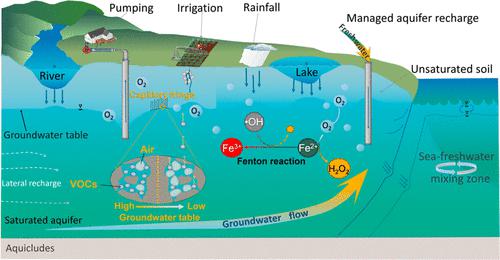当前位置:
X-MOL 学术
›
Environ. Sci. Technol.
›
论文详情
Our official English website, www.x-mol.net, welcomes your
feedback! (Note: you will need to create a separate account there.)
A Critical Review of Groundwater Table Fluctuation: Formation, Effects on Multifields, and Contaminant Behaviors in a Soil and Aquifer System
Environmental Science & Technology ( IF 10.8 ) Pub Date : 2024-01-18 , DOI: 10.1021/acs.est.3c08543 Yaqiang Wei 1 , Yuling Chen 1 , Xinde Cao 2 , Minghui Xiang 1 , Yuan Huang 1 , Hui Li 1
Environmental Science & Technology ( IF 10.8 ) Pub Date : 2024-01-18 , DOI: 10.1021/acs.est.3c08543 Yaqiang Wei 1 , Yuling Chen 1 , Xinde Cao 2 , Minghui Xiang 1 , Yuan Huang 1 , Hui Li 1
Affiliation

|
The groundwater table fluctuation (GTF) zone is an important medium for the hydrologic cycle between unsaturated soil and saturated aquifers, which accelerates the migration, transformation, and redistribution of contaminants and further poses a potential environmental risk to humans. In this review, we clarify the key processes in the generation of the GTF zone and examine its links with the variation of the hydrodynamic and hydrochemistry field, colloid mobilization, and contaminant migration and transformation. Driven by groundwater recharge and discharge, GTF regulates water flow and the movement of the capillary fringe, which further control the advection and dispersion of contaminants in soil and groundwater. In addition, the formation and variation of the reactive oxygen species (ROS) waterfall are impacted by GTF. The changing ROS components partially determine the characteristic transformation of solutes and the dynamic redistribution of the microbial population. GTF facilitates the migration and transformation of contaminants (such as nitrogen, heavy metals, non-aqueous phase liquids, and volatile organic compounds) through colloid mobilization, the co-migration effect, and variation of the hydrodynamic and hydrochemistry fields. In conclusion, this review illustrates the limitations of the current literature on GTF, and the significance of GTF zones in the underground environment is underscored by expounding on the future directions and prospects.
中文翻译:

地下水位波动的批判性回顾:土壤和含水层系统中的形成、对多场的影响以及污染行为
地下水位波动(GTF)带是非饱和土壤和饱和含水层之间水文循环的重要介质,加速了污染物的迁移、转化和重新分配,进一步对人类构成潜在的环境风险。在这篇综述中,我们阐明了 GTF 区域生成的关键过程,并研究了其与水动力和水化学场的变化、胶体流动以及污染物迁移和转化的联系。 GTF在地下水补给和排泄的驱动下,调节水流和毛细管边缘的运动,进一步控制土壤和地下水中污染物的平流和扩散。此外,活性氧(ROS)瀑布的形成和变化也受到GTF的影响。 ROS成分的变化部分决定了溶质的特征转化和微生物种群的动态重新分布。 GTF通过胶体动员、共迁移效应以及水动力和水化学场的变化促进污染物(例如氮、重金属、非水相液体和挥发性有机化合物)的迁移和转化。总之,本文阐述了当前GTF文献的局限性,并通过阐述未来的方向和前景,强调了GTF区在地下环境中的重要性。
更新日期:2024-01-18
中文翻译:

地下水位波动的批判性回顾:土壤和含水层系统中的形成、对多场的影响以及污染行为
地下水位波动(GTF)带是非饱和土壤和饱和含水层之间水文循环的重要介质,加速了污染物的迁移、转化和重新分配,进一步对人类构成潜在的环境风险。在这篇综述中,我们阐明了 GTF 区域生成的关键过程,并研究了其与水动力和水化学场的变化、胶体流动以及污染物迁移和转化的联系。 GTF在地下水补给和排泄的驱动下,调节水流和毛细管边缘的运动,进一步控制土壤和地下水中污染物的平流和扩散。此外,活性氧(ROS)瀑布的形成和变化也受到GTF的影响。 ROS成分的变化部分决定了溶质的特征转化和微生物种群的动态重新分布。 GTF通过胶体动员、共迁移效应以及水动力和水化学场的变化促进污染物(例如氮、重金属、非水相液体和挥发性有机化合物)的迁移和转化。总之,本文阐述了当前GTF文献的局限性,并通过阐述未来的方向和前景,强调了GTF区在地下环境中的重要性。


















































 京公网安备 11010802027423号
京公网安备 11010802027423号